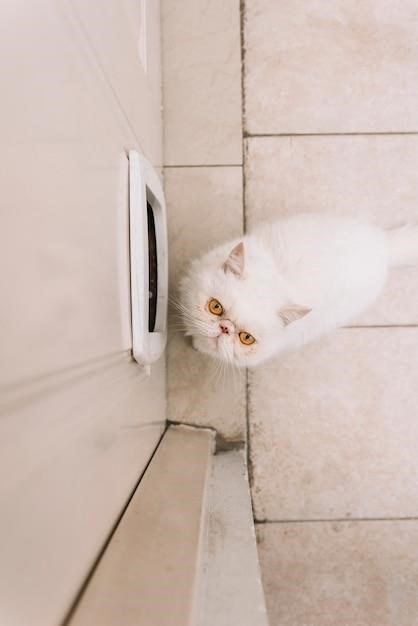Cat Mate Cat Flap Installation⁚ A Comprehensive Guide
This guide provides a step-by-step approach to installing your Cat Mate cat flap. From selecting the appropriate model for your door or wall to programming the microchip, we’ll cover everything you need for a successful installation. Troubleshooting tips and safety advice are included to ensure a smooth process. Remember to consult your specific Cat Mate model’s instructions for detailed guidance.
Choosing the Right Cat Flap
Selecting the correct Cat Mate cat flap hinges on several key factors. Consider your cat’s size; a larger cat will necessitate a larger flap. The material of your door or wall is crucial; Cat Mate offers models designed for wood, plastic, metal, UPVC, and glass. Measure your door’s thickness carefully, as some models require adapter kits for thicker materials (like the 361 adapter for UPVC/metal doors exceeding 35mm). Do you need a simple flap or a more advanced microchip model? Microchip versions offer controlled access, preventing unwanted animals from entering, and allowing you to program up to 30 cats. The Cat Mate Elite series, for instance, offers a range of features like selective ID discs and locking mechanisms. Think about your budget and desired features. Some models include four-way locking mechanisms for added security, while others offer simpler designs. Ultimately, choosing the right flap ensures a seamless installation and years of trouble-free use for both you and your feline companion. Carefully review the specifications of each Cat Mate model to ensure compatibility with your home and pet’s needs.

Preparing for Installation⁚ Tools and Materials
Before commencing the installation, gather the necessary tools and materials. This will streamline the process and prevent interruptions. You’ll need a pencil for marking, a measuring tape for precise measurements, a screwdriver (likely both Phillips and flathead), and possibly a drill with appropriate drill bits depending on your door or wall material. For certain installations, particularly in thicker doors or walls, you may need a jigsaw or hole saw to cut the appropriate opening. Safety glasses are crucial to protect your eyes from debris. Ensure you have the correct screws provided with your Cat Mate cat flap; additional screws may be necessary depending on your installation surface. If installing in a UPVC or metal door thicker than 35mm, remember to acquire the Cat Mate Cat Flap Adapter Kit (Ref. 361). Having all materials readily available, including the batteries for the microchip model if applicable (usually 4 x AA batteries), will allow for an efficient and safe installation. Check your Cat Mate instructions for specific requirements for your chosen model.
Installing the Cat Flap in a Door
Installing your Cat Mate cat flap in a door requires careful measurement and precision. Begin by selecting the desired location on your door, considering your cat’s access and avoiding any structural elements. Use a pencil to mark the outline of the cat flap template provided, ensuring it’s level and plumb. Carefully drill pilot holes at the marked corners to guide the jigsaw or hole saw. Cut the hole slowly and steadily, following the marked lines to avoid splintering or damage to the door. If working with a particularly thick door or a material like UPVC, you may need to use the appropriate adapter kit as mentioned in the instructions. Once the hole is cut, carefully remove any burrs or rough edges. Now, align the inner frame of the cat flap with the hole and secure it using the provided screws. Repeat this process for the outer frame, ensuring both frames are securely fixed. Finally, attach the flap itself and test its operation. Remember to consult your specific Cat Mate model’s instructions for precise details on screw placement and frame alignment. Properly securing the flap prevents drafts and ensures long-lasting functionality.
Installing the Cat Flap in a Wall or Window
Installing a Cat Mate cat flap in a wall or window presents a slightly different challenge compared to a door. First, carefully choose a location that is accessible to your cat and structurally sound. You’ll need to ensure there are no obstructions behind the wall or window that will interfere with the flap’s mechanism. For walls, you’ll need to cut a hole of the appropriate size using a suitable tool like a rotary drill or a masonry bit, depending on the material. With windows, consider the type of glass, as you may need specialized tools or may prefer to replace the pane altogether. Before cutting, always double-check your measurements against the cat flap’s template to ensure a precise fit. Once the hole is created, carefully clear away any debris and ensure the edges are smooth. Then, fit the inner frame of the cat flap, securing it firmly in place. Repeat this for the outer frame, paying close attention to alignment and ensuring a tight seal to prevent drafts. Finally, attach the flap itself and test its operation, ensuring smooth movement and a secure closure. Remember to refer to your specific Cat Mate model’s instructions for guidance on wall or window-specific installation techniques and material considerations. Always prioritize safety and work carefully to prevent damage to your property.

Programming Your Cat’s Microchip
Programming your Cat Mate microchip cat flap is a crucial step to ensure only your cat(s) can access your home. Before beginning, ensure your cat is microchipped; if not, consult your veterinarian. Most Cat Mate models will require you to initially insert batteries into the unit. Once powered, refer to your specific model’s instructions, which typically involves a simple button sequence to enter the programming mode. The process usually includes registering the microchip ID. This is often done by scanning your cat’s microchip with a device included with the cat flap or an external scanner. The cat flap then registers the unique microchip code. You might need to repeat this process for each cat. Some models have a maximum number of registered microchips, and this is outlined in your manual. After successfully registering the microchip(s), test the system. Your cat should be able to pass through the flap without issue, while other animals with different microchip IDs are blocked. If your cat cannot pass, double-check the instructions and ensure the microchip is correctly scanned. If issues persist, consult the Cat Mate troubleshooting guide or contact customer support. Remember, proper programming ensures the security and functionality of your Cat Mate microchip cat flap.
Troubleshooting Common Issues
Encountering problems with your Cat Mate cat flap? Let’s address some common issues. If the flap isn’t opening or closing correctly, first check the batteries. Replace them with fresh AA batteries, ensuring correct polarity. Next, examine the flap mechanism for any obstructions. Remove any debris or hair that may be hindering its movement. If the microchip isn’t recognized, ensure your cat is microchipped and the microchip ID is correctly programmed in the cat flap. Refer to the programming instructions in your manual. If the flap is sticking, you may need to lubricate the moving parts with a silicone-based lubricant. Avoid using oil-based products, as these can attract dirt and damage the mechanism. If the unit is not responding, check the power supply. Some models have power switches that can be accidentally turned off. If you’ve checked all of the above and the issue persists, consider the possibility of a faulty component. Contact Cat Mate customer support for assistance or to explore repair/replacement options. Keep a record of the troubleshooting steps you’ve taken, including dates, actions, and results, to assist in diagnosing the problem more effectively and provide valuable context if you need to contact support. Remember to always consult your specific model’s instruction manual for detailed troubleshooting advice.
Maintaining Your Cat Flap
Regular maintenance ensures your Cat Mate cat flap functions optimally and extends its lifespan. Begin by inspecting the flap and its surrounding area for any signs of wear and tear, damage, or debris buildup. Clean the flap regularly using a soft cloth and mild detergent. Avoid harsh chemicals or abrasive cleaners that could damage the materials. Pay close attention to the hinges and moving parts, ensuring they move freely and smoothly. If necessary, apply a small amount of silicone-based lubricant to reduce friction. Periodically check the batteries and replace them as needed to maintain consistent operation. Inspect the seals and weather stripping for any damage or deterioration. Replace worn seals to maintain a proper seal against drafts and weather conditions. For microchip models, ensure the microchip reader is clean and unobstructed. Remove any dust or debris that could interfere with the reader’s performance. If your Cat Mate flap has a locking mechanism, regularly test its functionality to ensure it works correctly. If you notice any issues with the flap’s operation, consult the troubleshooting section of your instruction manual or seek assistance from Cat Mate customer support. Remember that preventative maintenance is key to preventing more serious problems and extending the life of your pet door. By following these simple maintenance steps, you can help ensure your Cat Mate cat flap provides years of reliable service for your feline companion.
Safety Considerations and Tips
Prioritizing safety during and after installation is crucial. Ensure the cat flap is securely fastened to prevent accidental removal or damage. Regularly check the installation for any loose screws or parts, tightening as needed. Supervise your cat’s initial use of the flap to ensure they understand its operation and to prevent any accidents. If installing in a glass door or window, use appropriate safety glass to minimize the risk of injury from shattering. Consider adding a protective cover or screen around the exterior of the flap to deter potential intruders or prevent damage from weather conditions. For microchip models, ensure only authorized cats are registered to avoid unauthorized access. Never leave keys in the door near the cat flap, as this presents a security risk. If you notice any signs of tampering or damage, address the issue promptly to prevent potential problems. Regularly inspect the flap’s mechanism for any signs of wear or tear, replacing parts as needed. Keep children away from the installation area during installation and while the cat flap is in use. Always follow the manufacturer’s instructions carefully during the installation process. If you encounter any difficulties during the installation or experience any unexpected issues, consult a professional for assistance. Prioritize your pet’s safety and your home’s security by regularly checking the cat flap and addressing any potential safety concerns.



